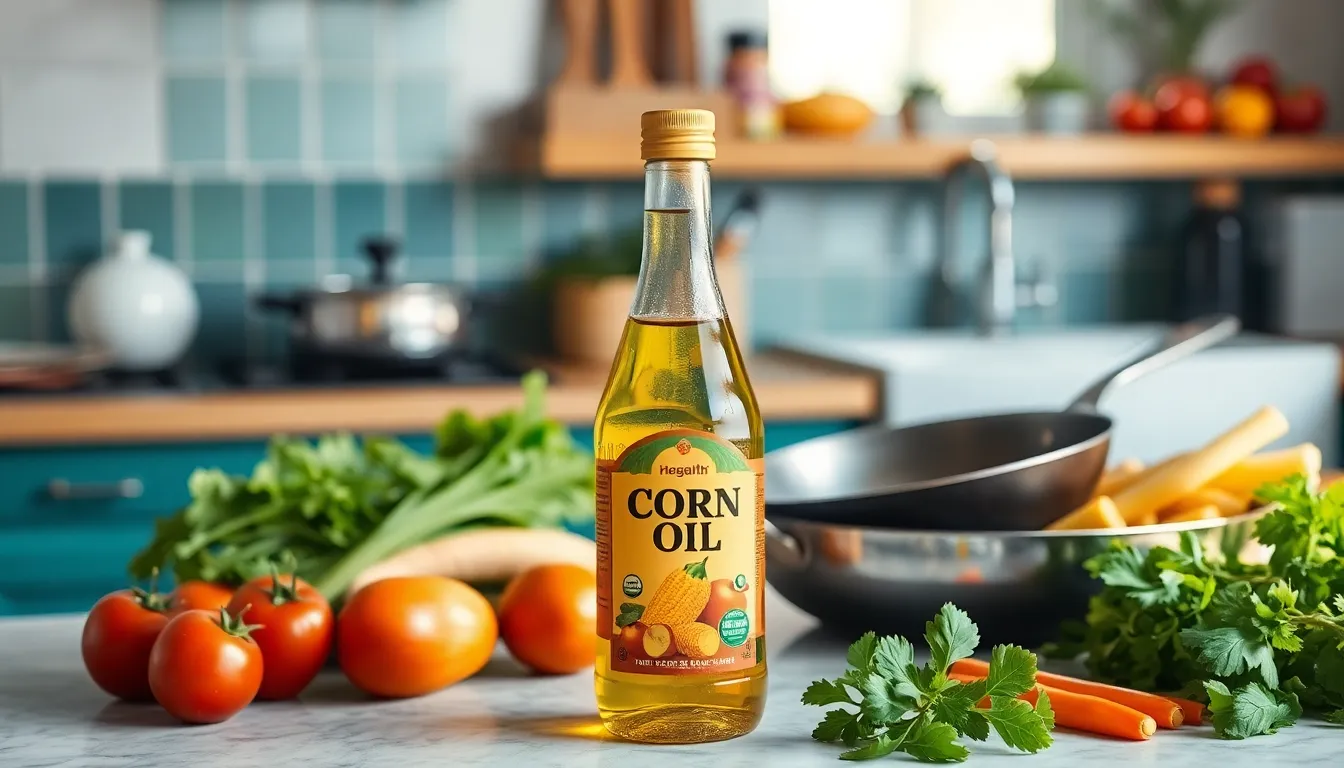Corn oil has been a staple in kitchens for years, but is it really the golden elixir it claims to be? As it turns out, this liquid gold might not be the superhero of cooking oils after all. With its smooth texture and mild flavor, it’s often the go-to choice for frying and baking. But before you pour it into your frying pan, let’s dig a little deeper into what makes corn oil tick—or tock, as its health implications might suggest.
While corn oil may seem innocent, lurking beneath its sunny surface are some questionable qualities. Is it packed with omega-6 fatty acids that can throw off your body’s balance? Or could it be contributing to that muffin top you’ve been trying to lose? Join the quest to uncover the truth about corn oil and whether it deserves a spot in your pantry or should be shown the door.
Table of Contents
ToggleUnderstanding Corn Oil
Corn oil serves as a popular cooking oil, known for its neutral taste and versatility. Its widespread use in kitchens raises questions about its health effects.
What Is Corn Oil?
Corn oil derives from the germ of corn kernels. It undergoes refining processes that enhance its smoking point, making it suitable for frying and baking. Processed corn oil contains high amounts of polyunsaturated fats, primarily omega-6 fatty acids. These fatty acids play a role in various bodily functions but excessive consumption can lead to health concerns.
Nutritional Profile of Corn Oil
Corn oil contains approximately 120 calories per tablespoon. It consists mostly of fats, with about 14 grams of total fat per serving. Within this, nearly 8 grams represent polyunsaturated fats. Omega-6 fatty acids account for a significant portion of these fats, and most individuals consume higher levels than recommended. Despite lacking essential nutrients like vitamins and minerals, corn oil remains calorie-dense, which can contribute to dietary imbalances if not used in moderation.
Health Effects of Corn Oil

Corn oil has both benefits and drawbacks that merit consideration. Understanding these effects helps in making informed dietary choices.
Positive Aspects of Corn Oil
Corn oil contains polyunsaturated fats, which can support heart health when used in moderation. It provides vitamin E, an antioxidant that helps protect the body from oxidative stress. The neutral flavor of corn oil makes it a versatile ingredient for cooking and baking, allowing it to enhance various dishes without altering their taste. Additionally, its high smoke point, around 450°F, enables safer frying by reducing the production of harmful compounds during cooking. Corn oil also contributes to energy intake, with about 120 calories and 14 grams of total fat per tablespoon, making it a viable option for those requiring additional caloric intake.
Potential Risks Associated with Corn Oil
Excessive omega-6 fatty acid consumption may disrupt the body’s omega-3 to omega-6 balance, potentially leading to inflammation. High processing levels in corn oil often strip away beneficial nutrients, resulting in a calorie-dense product lacking essential vitamins and minerals. Regular use without moderation can contribute to dietary imbalances. Concerns exist regarding corn oil’s potential links to chronic diseases, particularly when it replaces healthier fat sources like olive or avocado oil. Awareness of these risks is key to making better nutritional choices.
Comparing Corn Oil to Other Oils
Corn oil and olive oil differ significantly in composition and health effects. Olive oil, rich in monounsaturated fats, promotes heart health and reduces inflammation. Corn oil, with its high omega-6 fatty acid content, may lead to an imbalance in fatty acids if consumed excessively. While one tablespoon of corn oil contains about 120 calories and 14 grams of total fat, olive oil provides a similar calorie count but with beneficial nutrients and antioxidants. The smoking point of corn oil makes it suitable for high-heat cooking, but olive oil’s flavor enhances dishes while still providing health benefits.
Coconut oil stands apart from both corn oil and olive oil. Known for its medium-chain triglycerides, coconut oil may boost metabolism and energy levels. Corn oil contains primarily polyunsaturated fats, making it less favorable for those seeking natural sources of energy. While a tablespoon of coconut oil offers around 120 calories, it lacks the omega-6 fatty acids prevalent in corn oil. Cooking with coconut oil can impart a distinct flavor, which contrasts sharply with the neutral taste of corn oil, emphasizing personal preference in culinary applications.
Recommendations for Consumption
Moderation plays a key role when using corn oil in cooking. It’s essential to limit intake due to its high omega-6 fatty acid content. Consuming no more than 1-2 tablespoons per day is advisable to maintain a healthy balance of fatty acids in the diet. Individuals should pay attention to overall dietary fat sources to avoid excess omega-6 and potential inflammation. Monitoring food labels for corn oil is beneficial, ensuring it doesn’t dominate the dietary fat intake.
How Much Corn Oil Is Safe?
Corn oil consumption thresholds vary based on individual dietary needs. It’s recommended not to exceed 14 grams of total fat per tablespoon, factoring in other fat sources throughout the day. For balanced health, including a variety of oils increases nutrient diversity. Some experts advocate for limiting omega-6 intake to less than 5% of total daily calories, which guides how much corn oil one should use. Careful tracking of overall diet helps manage intake effectively.
Healthier Alternatives to Corn Oil
Several healthier oil options exist that provide different benefits. Olive oil stands out as a great alternative due to its rich monounsaturated fats, known for heart health support. Avocado oil also provides a similar health profile with high smoke points, making it suitable for cooking. For baking, coconut oil offers medium-chain triglycerides that boost metabolism and energy levels. Flaxseed oil, rich in omega-3 fatty acids, promotes anti-inflammatory effects and balances omega-6 intake when used in salad dressings. Prioritizing these alternatives enhances flavor while promoting better health outcomes.
Corn oil’s place in the kitchen comes with both benefits and risks. While it offers versatility and a high smoke point for cooking it also poses concerns due to its high omega-6 fatty acid content. This imbalance can lead to health issues if consumed excessively.
For those looking to maintain a balanced diet it’s essential to use corn oil in moderation and consider healthier alternatives that provide better nutritional profiles. Oils like olive oil and avocado oil not only enhance flavor but also support overall health. Making informed choices about cooking oils can contribute to a healthier lifestyle and well-being.









